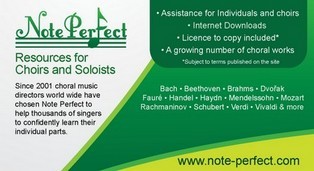Zadok the Priest - Coronation Anthem No 1 (Handel)
Choral
| Composer: | George Frideric Handel | |
| Voicing: | SSAATBB and organ or Keyboard | |
| Words: | 1 Kings 1:38–40 |
Zadok, the Priest, and Nathan, the Prophet, anointed Solomon King; and all the people rejoiced, and said:God save the King, long live the King, may the King live for ever! Amen! Alleluja!Rehearsal Training Aids for Zadok The Priest (Coronation Anthem No 1) can be obtained by clicking hereTwo versions:
- Choir with Organ accompaniment (3 Stave)
- Choir with Keyboard Accompaniment (2 Stave)
View or download the score
View or download the score
Young Nak Presbyterian Church Calvary Choir
at Bupyeong Methodist Church
at Bupyeong Methodist Church
The Sixteen
Zadok the Priest (HWV 258) is a coronation anthem
composed by George Frideric Handel (1685
-1759) using texts from the King James Bible. It is one of the four
Coronation Anthems that Handel composed for the coronation of George II
of Great Britain in 1727. and has been sung at every subsequent British
coronation service. It is traditionally performed during the sovereign's
anointing.
Text
Although they have been part of the traditional content of British coronations, the texts for all four anthems were picked by Handel himself, much to the consternation of the participating clergy. It is believed that Handel made a personal selection from the most accessible account of an earlier coronation, that of James II of England in 1685. Though the text derives from the biblical account of the anointing of Solomon, it is not a direct quote, but a paraphrase, possibly by the composer himself.
Full text
After 1 Kings 1:38-40Zadok, the Priest and Nathan, the Prophet anointed Solomon King.
And all the people rejoic'd, and said:
'God save The King, long live The King, may The King live for ever! Amen.
Structure
Zadok the Priest is written for SS-AA-T-BB chorus and orchestra (two oboes, two bassoons, three trumpets, timpani, strings, continuo). The music builds up tension in its orchestral introduction, by layering semiquavers and quavers together, and then when the choir comes in a sense of drama by having the choir sing in the longer notes of crotchets and minims.The middle section "And all the people rejoic'd, and said" is an imitatory dance in 3/4 time, mainly with the choir singing chordally and a dotted rhythm in the strings.The final section "God save the King, etc" is a return to common time (4/4), with the "God Save the King" section heard chordally, interspersed with the Amens incorporating long semiquaver runs which are taken in turn through the six voice parts (SAATBB) with the other parts singing quaver chords accompanying it. The chorus ends with a largo Baroque cadence on "Alleluia".
Other uses
This article is licensed under the GNU Free Documentation License. It
uses material from the Wikipedia article "Metasyntactic variable".
Comments
Please make comment on the score and music here.
- Keep to the topic of the music on this page. Be polite, comments are moderated
- Tell us where you have used this music and if your performance is published on the internet, please put a link to it in the website field
- Give performance advice/suggestions
- Ask others questions about performance techniques
- Please do not make requests for music on this page
- Your email address is not published
0
reviews
Our sponsors
Other Choral Music
